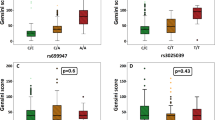Abstract
The molecular-genetic testing of the polymorphic rs2981579 (C>T) locus of the FGFR2 gene as the marker of increased predisposition to the development of mesial occlusion was carried out in 110 patients with mesial occlusion and 103 general-population control subjects from Ukraine. It was shown that polymorphism rs2981579 in gene FGFR2 is associated with mesial occlusion (OR = 1.67, 95% CI = 1.14–2.45, p = 0.009). Compared to CC carriers, TT+CT carriers had a 3.21-fold higher risk of mesial occlusion (95% CI = 1.57–6.57, p = 0.001). We found the protective effect of the homozygous allele C on mesial occlusion development (OR = 0.31, p = 0.001). This is the first published data on FGFR2 polymorphisms rs2981579 (C>T) in patients with mesial occlusion.
Similar content being viewed by others
References
Mossey, P.A., The heritability of malocclusion. Part 2. The influence of genetics in malocclusion, Br. J. Orthod., 1999, vol. 26, no. 3, pp. 195–203.
Jena, A.K., Duggal, R., Mathur, V.P., and Par-kash, H., Class-III malocclusion: Genetics or environment? A twins study, J. Indian Soc. Pedod. Prev. Dent., 2005, vol. 23, no. 1, pp. 27–30.
Tomoyasu, Y., Yamaguchi, T., and Maki, K., Recent advances in the genetics of orthodontics, in Principles in Contemporary Orthodontics, Naretto, S., Ed., InTech, 2011, pp. 569–584.
Vela, K.C., Phenotypic characterization of class CIII malocclusion, Dis. MS Thesis, Univ. Iowa, 2012, 83 p.
Xue, F., Wong, R.W., and Rabie, A.B., Genes, genetics, and Class III malocclusion, Orthod. Craniofac. Res., 2010, vol. 13, no. 2, pp. 69–74.
Tomaszewska, A., Kopczynski, P., and Flieger, R., Genetic basis of mandibular prognathism, Arch. Biomed. Sci., 2013, vol. 1, no. 2, pp. 16–19.
Weaver, C.A., Candidate gene analysis of 3D dental phenotypes in patients with malocclusion, Dis. MS Thesis, Univ. Iowa, 2014, 142 p.
Jankovska, I., Pilmane, M., Urtane, I., Bigestans, A., Salms, G., and Lauskis, G., Growth factors, apoptotic cells and barx1 gene in bone and soft tissue of skeletal class III patients, Stomatologija, 2007, vol. 9, no. 2, pp. 40–46.
Suh, Y.J., Bae, H.S., Choi, J.Y., Lee, J.H., Kim, M.J., Kim, S., Ryoo, H.M., and Baek, S.H., A novel FGFR2 mutation in tyrosine kinase II domain, L617F, in Crouzon syndrome, J. Cell. Biochem., 2014, vol. 115, no. 1, pp. 102–110.
Baird, A., and Bhlen, P., Fibroblast growth factors, in Peptide Growth Factors and Their Receptors I, Sporn, M. and Roberts, A.B., Eds, Springer, 1990, pp. 369–418.
Zhou, L., Yao, F., Luan, H., Wang, Y., Dong, X., Zhou, W., and Wang, Q., Three novel functional polymorphisms in the promoter of FGFR2 gene and breast cancer risk: a HuGE review and meta-analysis, Breast Cancer Res. Treat., 2012, vol. 136, no. 3, pp. 885–897.
Cakan, D.G., Ulkur, F., and Taner, T., The genetic basis of facial skeletal characteristics and its relation with orthodontics, Eur. J. Dent., 2012, vol. 6, no. 3, pp. 340–345.
Boyadjiev, S.A., Genetic analysis of non-syndromic craniosynostosis, Orthod. Craniofac. Res., 2007, vol. 10, no. 3, pp. 129–137.
Beenken, A., and Mohammadi, M., The FGF family: biology, pathophysiology and therapy, Nat. Rev. Drug Discov., 2009, vol. 8, no. 3, pp. 235–253.
Nikopensius, T., Saag, M., Jagomдgi, T., Annilo, T., Kals, M., Kivistik, P.A., Milani, L., and Metspa-lu, A., A missense mutation in DUSP6 is associated with class III malocclusion, J. Dent. Res., 2013, vol. 92, no. 10, pp. 893–898.
Cruz, R.M., Hartsfield, J.K. Jr, Falcгo-Alencar, G., Koller, D.L., Pereira, R.W., Mah, J., Ferrari, I., and Oliveira, S.F., Exclusion of Class III malocclusion candidate loci in Brazilian families, J. Dent Res., 2011, vol. 90, no. 10, pp. 1202–1205.
Author information
Authors and Affiliations
Corresponding author
Additional information
Original Ukrainian Text © K.V. Storozhenko, V.M. Shkarupa, 2017, published in Tsitologiya i Genetika, 2017, Vol. 51, No. 5, pp. 50–54.
About this article
Cite this article
Storozhenko, K.V., Shkarupa, V.M. Association of FGFR2 (rs2981579) gene polymorphism with the risk of mesial occlusion. Cytol. Genet. 51, 361–364 (2017). https://doi.org/10.3103/S0095452717050103
Received:
Published:
Issue Date:
DOI: https://doi.org/10.3103/S0095452717050103



